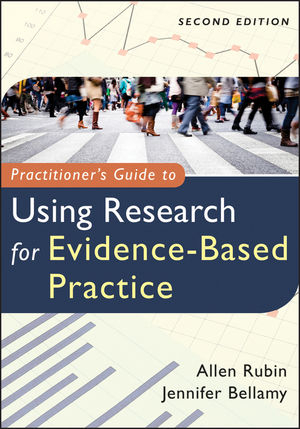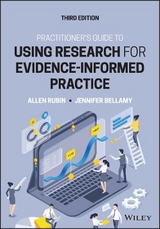
Practitioner′s Guide to Using Research for Evidence–Based Practice 2e
John Wiley & Sons Inc (Verlag)
978-1-118-13671-3 (ISBN)
Written by a proven author and top scholar in research methods, Practitioner's Guide to Using Research for Evidence-Based Practice gives essential and practical guidance on how to integrate research appraisal into evidence-based practice endeavors to ensure best client care. This practitioner-oriented book provides readers across the helping professions with the step-by-step skills they need to effectively appraise and use research as part of the evidence-based practice process. Readers will have the ability to integrate evidence-based treatments that improve the delivery of care and optimize treatment success as a result.
Allen Rubin, Ph.D. is the Kantambu Latting College Professorship for Leadership and Change at the University of Houston Graduate College of Social Work. He is the author of a number of best-selling titles in social work research and he currently serves as Chair of the Evidence-Based Practice track for the Council on Social Work Education. Dr. Rubin led an international symposium on Improving Teaching of EBP. Jennifer Bellamy, PhD, is an Assistant Professor at the School of Social Service Administration at The University of Chicago, where she has been a faculty member since 2008. She has numerous publications in the area of EBP in social work.
Preface xiii Acknowledgments xxi About the Authors xxiii PART I: Overview of Evidence-Based Practice Chapter 1 Introduction to Evidence-Based Practice 3 Emergence of Evidence-Based Practice 5 Defi ning Evidence-Based Practice 6 Types of EBP Questions 7 Evidence-Based Practice Is Not Restricted to Clinical Decisions 17 Developing an Evidence-Based Practice Process Outlook 17 Easier Said Than Done 23 Key Chapter Concepts 25 Review Exercises 26 Additional Readings 27 Chapter 2 Steps in the EBP Process 28 Step 1: Question Formulation 29 Step 2: Evidence Search 30 Step 3: Critically Appraising Studies and Reviews 38 Step 4: Selecting and Implementing the Intervention 40 Step 5: Monitor Client Progress 43 Feasibility Constraints 44 Key Chapter Concepts 47 Review Exercises 48 Additional Readings 49 Chapter 3 Research Hierarchies: Which Types of Research Are Best for Which Questions? 50 More Than One Type of Hierarchy for More Than One Type of EBP Question 51 Qualitative and Quantitative Studies 53 What Types of Research Designs Apply to What Types of EBP Questions? 54 Key Chapter Concepts 65 Review Exercises 67 Additional Readings 67 PART II: Critically Appraising Studies for EBP Questions About Intervention Effectiveness Chapter 4 Criteria for Inferring Effectiveness: How Do We Know What Works? 71 Internal Validity 72 Measurement Issues 78 Statistical Chance 83 External Validity 88 Synopses of Research Studies 90 Key Chapter Concepts 95 Review Exercises 96 Exercise for Critically Appraising Published Articles 97 Additional Readings 98 Chapter 5 Critically Appraising Experiments 99 Classic Pretest Posttest Control Group Design 100 Posttest-Only Control Group Design 102 Solomon Four-Group Design 103 Alternative Treatment Designs 104 Dismantling Designs 106 Placebo Control Group Designs 107 Experimental Demand and Experimenter Expectancies 109 Obtrusive Versus Unobtrusive Observation 110 Compensatory Equalization and Compensatory Rivalry 111 Resentful Demoralization 111 Treatment Diffusion 112 Treatment Fidelity 113 Practitioner Equivalence 113 Differential Attrition 115 Synopses of Research Studies 117 Key Chapter Concepts 123 Review Exercises 124 Exercise for Critically Appraising Published Articles 125 Additional Readings 125 Chapter 6 Critically Appraising Quasi-Experiments: Nonequivalent Comparison Groups Designs 126 Nonequivalent Comparison Groups Designs 127 Additional Logical Arrangements to Control for Potential Selectivity Biases 130 Statistical Controls for Potential Selectivity Biases 134 Propensity Score Matching Using a Policy Example 144 Pilot Studies 145 Synopses of Research Studies 147 Key Chapter Concepts 152 Review Exercises 153 Exercise for Critically Appraising Published Articles 153 Additional Readings 154 Chapter 7 Critically Appraising Quasi-Experiments: Time-Series Designs and Single-Case Designs 155 Simple Time-Series Designs 156 Multiple Time-Series Designs 159 Single-Case Designs 161 Synopses of Research Studies 168 Key Chapter Concepts 174 Review Exercises 175 Exercise for Critically Appraising Published Articles 176 Additional Reading 176 Chapter 8 Critically Appraising Systematic Reviews and Meta-Analyses 177 Advantages of Systematic Reviews and Meta-Analyses 179 Risks in Relying Exclusively on Systematic Reviews and Meta-Analyses 180 Where to Start 181 What to Look for When Critically Appraising Systematic Reviews 182 What Distinguishes a Systematic Review From Other Types of Reviews? 190 What to Look for When Critically Appraising Meta-Analyses 191 Synopses of Research Studies 205 Key Chapter Concepts 209 Review Exercises 211 Exercise for Critically Appraising Published Articles 212 Additional Readings 212 PART III: Critically Appraising Studies for Alternative EBP Questions Chapter 9 Critically Appraising Nonexperimental Quantitative Studies 215 Surveys 216 Cross-Sectional and Longitudinal Studies 228 Case-Control Studies 229 Synopses of Research Studies 231 Key Chapter Concepts 240 Review Exercises 242 Exercise for Critically Appraising Published Articles 242 Additional Readings 242 Chapter 10 Critically Appraising Qualitative Studies 243 Qualitative Observation 245 Qualitative Interviewing 247 Qualitative Sampling 250 Grounded Theory 252 Frameworks for Appraising Qualitative Studies 252 Mixed Model and Mixed Methods Studies 257 Synopses of Research Studies 258 Key Chapter Concepts 266 Review Exercises 271 Exercise for Critically Appraising Published Articles 272 Additional Readings 272 PART IV: Assessing Clients and Monitoring Their Progress Chapter 11 Critically Appraising and Selecting Assessment Instruments 275 Reliability 276 Validity 280 Sensitivity 285 Feasibility 287 Sample Characteristics 288 Locating Assessment Instruments 289 Synopses of Research Studies 291 Key Chapter Concepts 296 Review Exercises 297 Exercise for Critically Appraising Published Articles 298 Additional Readings 298 Chapter 12 Monitoring Client Progress 299 A Practitioner-Friendly Design 301 Feasible Assessment Techniques 304 Summary 313 Looking Ahead 316 Key Chapter Concepts 318 Review Exercises 319 Additional Readings 319 Appendix A Illustrative Answers to Selected Review Exercises 321 Chapter 3 Review Exercises 321 Chapter 4 Review Exercises 322 Chapter 5 Review Exercises 323 Chapter 7 Review Exercises 324 Chapter 8 Review Exercises 324 Chapter 12 Review Exercises 325 Appendix B What You Do and Don t Need to Know About Statistics When Critically Appraising Studies 327 Why Do We Need Inferential Statistics? The Bottom Line 328 The Benchmark Made Simple 329 Is That Really All You Need to Know? 330 The Benchmark Is Not Sacred! 331 What Else Do You Need to Know? 332 Conclusion 333 Glossary 335 References 345 Index 351
| Erscheint lt. Verlag | 7.9.2012 |
|---|---|
| Verlagsort | New York |
| Sprache | englisch |
| Maße | 181 x 251 mm |
| Gewicht | 748 g |
| Themenwelt | Geisteswissenschaften ► Psychologie |
| Naturwissenschaften ► Chemie | |
| Sozialwissenschaften ► Pädagogik ► Sozialpädagogik | |
| Sozialwissenschaften ► Soziologie ► Empirische Sozialforschung | |
| ISBN-10 | 1-118-13671-3 / 1118136713 |
| ISBN-13 | 978-1-118-13671-3 / 9781118136713 |
| Zustand | Neuware |
| Haben Sie eine Frage zum Produkt? |
aus dem Bereich



